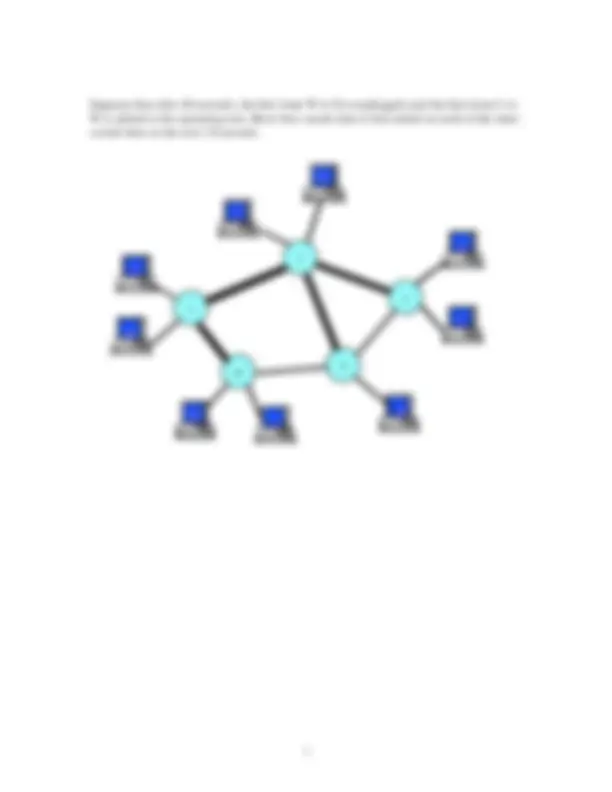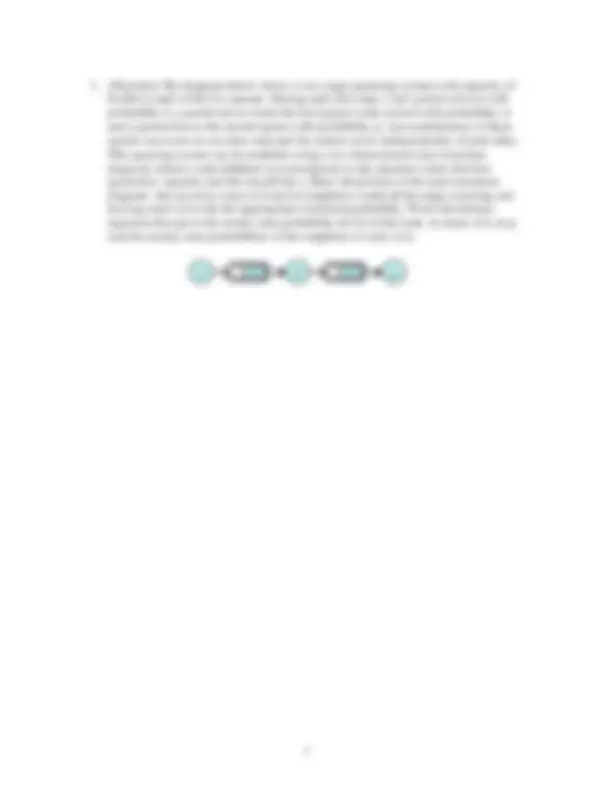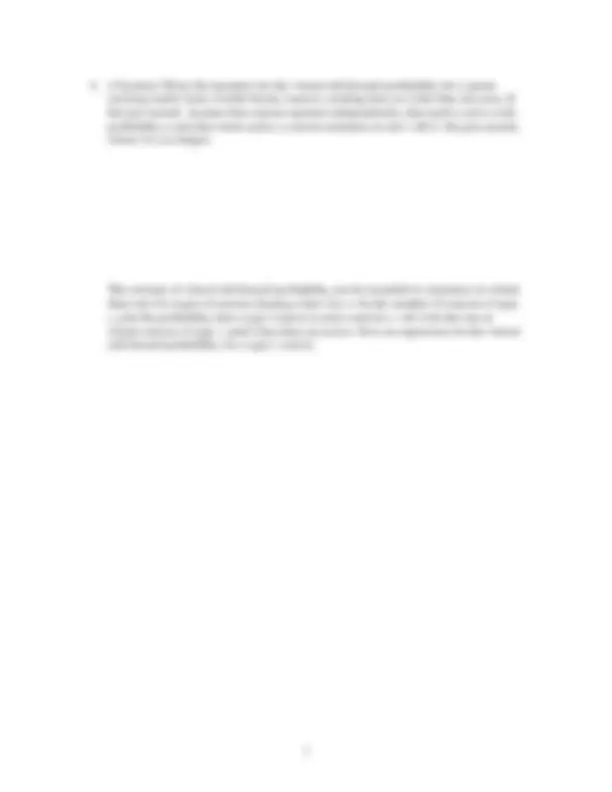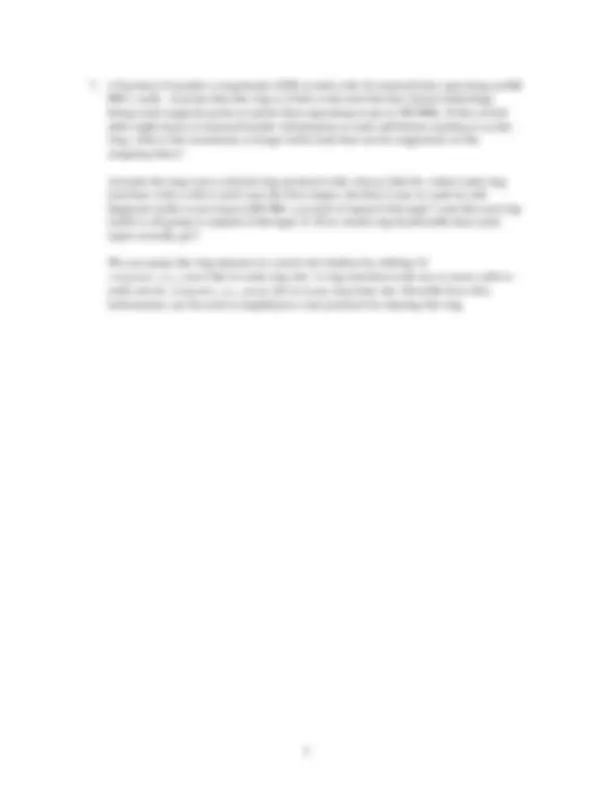Download Exam Questions for CS/EE 577: Networking - Part 1 and more Exams Design and Analysis of Algorithms in PDF only on Docsity!
CS/EE 577 — Exam 1
- (10 points). The figure below shows a multibit trie used for IP route lookups. Draw the equivalent binary trie. Draw nodes corresponding to prefixes using shading and draw other nodes as open circles.
00 01 10
11
01 01
00 01
11 01 00 10
1 0,1 -^0
0
1 -
0 1
1 0 0 1
00 01 10
11
01 01
00 01
11 01 00 10
1 0,1 -^0
0
1 -
0 1
1 0 0 1
- (10 points) Assume that the switched Ethernet LAN shown below uses 10 Mb/s bidirectional links between each pair of switches and that the links shown as heavy lines are the links belonging to the spanning tree used for data forwarding. Suppose at time 0 that terminals A and H start sending data to terrminal E at 7 Mb/s each and that E does not respond for the first 10 seconds. Show much data is forwarded in each direction on each of the inter-switch links during the first 10 seconds.
Suppose E sends a packet to A after 10 seconds. Show much data is forwarded on each of the inter-switch links in the next 10 seconds, assuming that A and H continue to transmit at 7 Mb/s each.
U
V
Y
W X
A
H J
B
F
E
D
C
G
U
V
Y
W X
A
H J
B
F
E
D
C
G
U
V
Y
W X
A
H J
B
F
E
D
C
G
U
V
Y
W X
A
H J
B
F
E
D
C
G
- (20 points) The diagram below shows a two stage queueing system with capacity of B cells in each of the two queues. During each time step, a new packet arrives with probability λ, a packet moves from the first queue to the second with probability σ and a packet leaves the second queue with probability μ. Any combination of these actions can occur in one time step and the actions occur independently of each other. This queuing system can be modeled using a two dimensional state transition diagram, where a state lableled ( i , j ) corresponds to the situation where the first queue has i packets and the second has j. Show the portion of the state transition diagram that involves state (3,2) and its neighbors. Label all the edges entering and leaving state (3,2) with the appropriate transition probability. Write the balance equation that gives the steady state probability π(3,2) of this state, in terms of λ, σ, μ and the steady state probabilities of the neighbors of state (3,2).
- (15 points) Write the equation for the virtual cell discard probability for a queue carrying traffic from n traffic bursty sources, sending data on a link that can carry R bits per second. Assume that sources operate independently, that each is active with probability p and that when active, a source transmits at rate r = R / k bits per second, where k is an integer.
The concept of virtual cell discard probability can be extended to situations in which there are two types of sources sharing a link. Let ni be the number of sources of type i , pi be the probability that a type i source is active and let ri = R / ki be the rate at which sources of type i send when they are active. Give an expression for the virtual cell discard probability for a type 1 source.
- (15 points) Consider the design of a cell switch that supports 64 links at 600 Mb/s each and uses a crossbar. Assume that the circuit technology supports point-to-point signals between chips at 150 Mb/s and that the crossbar chips are limited to 128 input pins and 128 output pins for the data. The input port processors each contain a FIFO queue and the switch is required to have good performance with fully loaded input links and uniform random traffic. How many separate chips are needed to implement the crossbar (neglecting the controller)? How would they be arranged? If the controller uses a time-slotted arbitration ring to select which inputs get to send to which outputs during each cell time, what clock rate will be needed to enable the controller to keep up with the fully loaded traffic rate.
- (15 points) Consider a ring-based ATM switch with 16 external links operating at 600 Mb/s each. Assume that the ring is 16 bits wide and that the circuit technology being used supports point-to-point lines operating at up to 200 MHz. If the switch adds eight bytes of internal header information to each cell before sending it on the ring, what is the maximum average traffic load that can be supported on the outgoing links?
Assume the ring uses a slotted ring protocol with a busy/idle bit, where each ring interface with a cell to send uses the first empty slot that it sees to send its cell. Suppose traffic is arriving at 600 Mb/s at each of inputs 0 through 7 and this arriving traffic is all going to outputs 8 through 15. How much ring bandwidth does each input actually get?
We can make the ring operate in a more fair fashion by adding 16 request_to_send bits in each ring slot. A ring interface with one or more cells to send sets its request_to_send_bit in every ring time slot. Describe how this information can be used to implement a fair protocol for sharing the ring.
- (15 points) Consider a bus-based cell switch with a sub-divided bus with 32 inputs and outputs. Suppose that each cell time, a cell arrives on each input with probability p and that each cell is assigned randomly to a different output. What is the probability that in a given cell time, output 0 receives exactly one cell? If the OPP at output 0 has a knockout concentrator that can forward up to eight cells per cell time into the OPP’s cell buffer, what is probability that in a given cell time, more cells arrive at output 0 than can be placed in the buffer? What is the probability that an arriving cell is discarded?




















